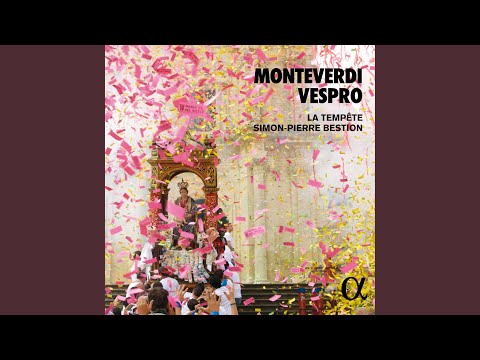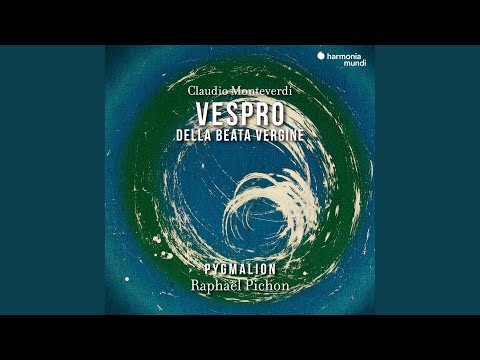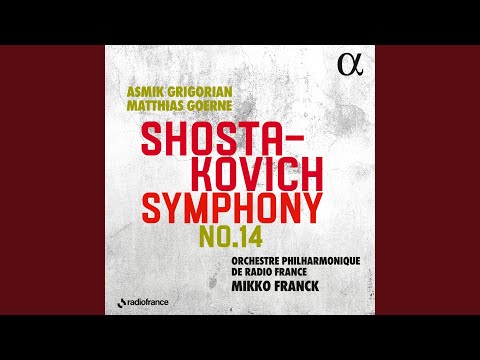- Simon-Pierre Bestion, La Tempête: “Vespro” (Alpha)
- Raphaël Pichon, Pygmalion, et. al.: “Monteverdi: ‘Vespro della Beata Vergine’” (Harmonia Mundi)
- Magdalena Kožená, Czech Philharmonic, Simon Rattle: “Folk Songs” (Pentatone)
- Asmik Grigorian, Matthias Goerne, Orchestre Philharmonique de Radio France, Mikko Franck: “Shostakovich: Symphony No. 14” (Alpha)
“Vespro” & “Vespro della Beata Vergine”
It’s rare that a new recording of a repertoire staple becomes a catalyst for a real-life version of the math lady meme, but Raphaël Pichon is exactly the sort of conductor you’d willingly follow down a rabbit hole. Given the relative recency of the Monteverdi revival, it’s also surprising how many recordings of the composer’s “Vespro della Beata Vergine” there are to wade through. John Eliot Gardiner’s 1994 recording with the Monteverdi Choir and Orchestra treats the setting of the Marian Vespers as one of the composer’s lost operas, performing the opening with stately splendor. In a period instrument recording, Harry Christophers and the Sixteen sound a bit more ramshackle; Paul McCreesh and the Gabrieli Consort reach a similar period effect under a dome of choral sound; Christina Pluhar and L’Arpeggiata play drastically with rhythm for moments that alternate between stymying and stunning; Seraphic Fire under Patrick Dupré Quigley reach ASMR-levels of vocal cohesion and blending, but at the expense of an almost nonexistent orchestra.
A few years ago for Alpha, Simon-Pierre Bestion and La Tempête recorded a version of the “Vespers” that managed to reconfigure the work on a molecular level. The opening call-and-response of “Deus in adjutorium meum intende” (“Make haste, oh God, to deliver me”) is an open-throated a cappella supplication delivered with fauxbourdons—the vocal drone effect favored by Burgundian troubadours in the Middle Ages and early Renaissance that also shares DNA with folk choir techniques from Bulgaria and, as famously demonstrated in 2021’s Eurovision Song Contest, Ukraine. The men’s choir sounds sweaty and musky in a potent delivery of “Domine ad adjuvandum me festina” (“Make haste to help me, oh Lord”).
This is the flame that Bestion kindles throughout his reading of the “Vespers,” illuminating his vision of what religious fervor and ecstasy meant at the dawn of the 17th century in Monteverdi’s Italy—“the kind of ‘heavenly length’ that holds us in the moment, cuts us off from the world for as long as it lasts, imposes a rhythm we are unused to – and at its best, can bring us moments of grace and wonder,” as he explains. It also broadens the range and palate of music in Monteverdi’s Italy: Born in Cremona, he grew up between Venice and Mantua, the two cities that would factor into his career. In the liner notes for his “Vespro,” Bestion makes repeated references to Venice’s cultural landscape as a city that served as the gateway from Italy to modern-day Turkey, Armenia, and Syria (Venice and Aleppo were effectively sister cities throughout Monteverdi’s lifetime).
Reviewing this album in 2019 for BBC Music Magazine, Berta Joncus points out that Monteverdi composed the “Vespers” before he moved to Venice. However, Monteverdi’s exposure to the city’s culture—and the foreign influences that helped to shape it—also predated his move to La Serenissima. He grew up in a Cremona that was under Venetian, French, and Spanish authority; his early books of madrigals were published in Venice before he even moved to Mantua. Once he did arrive in the city (which sits between Cremona and Venice), employed in the court of Vincenzo I Gonzaga, he traveled with his patron to Flanders (where he first encountered French song), and to Hungary for a military campaign that put him in direct contact with Ottoman forces. He also traveled within northern Italy, particularly around the time that he was writing his “Vespers” —he was in the market for a new job.
How much maqam would Monteverdi have heard on these trips? The letters that remain in print from his lifetime don’t reflect this—he’s mostly flattering nobility in hopes of getting more work and money. But Bestion is smart to link vocal lines like “Diffusa est gratia” to Arabic vocalises. Joncus dismisses these ornaments as “a Western fantasy of Eastern abandonment,” but I read it more as an exercise in what-ifs. Stretching his vocalists that much further, Bestion shows how this music comes full circle.
Which brings us back to Pygmalion’s new recording of the work. Raphaël Pichon (who has been ushering a new era of historically-informed performance with daredevil recordings including Bach’s “Saint Matthew Passion” and wife Sabine Devieilhe’s collection of Bach and Handel arias) has thought about the “Vespers” with the same depth and range as Bestion. “There is an extremely strong link to an immemorial oral tradition,” he says in the liner notes. “Monteverdi seems to draw on a sound-world of the imagination that comes from the dawn of time. The Vespro sometimes deals in antiphony, taking on the contours of Maronite music, of a muezzin’s call…The result is a form of universality, a shared heritage that takes shape around the Mediterranean basin and its traditions.”
There aren’t any Breton vocal drones in Pichon’s vision for “Vespers,” but there is a similar texture in the harmonies. That familiar opening Invitatotirum, with its echoes of “Orfeo” in the orchestra, is crisp and dry, the continuo echoing the tread of tightly-packed snow. It’s kindling for a sharp and dramatically incisive read of the work. Pichon leans into the stile rappresentativo impulses of a section like “Nigra sum”—more florid than recitative, less structured than an aria—which tenor Emiliano Gonzalez Toro sings with sensitive, cantorial ornamentation. His breath control gives the impression that he’s singing one unbroken vocal line across four minutes.
Gonzalez Toro also mixes especially well with fellow tenor Zachary Wilder. We hear this first in the “Duo Seraphim,” with both voices layered on top of one another, almost indistinguishable before they start to unweave and show their distinct textures and temperatures. Wilder, with a tendency towards the troubadours, is a few shades richer and darker, and the contrast gives that familiar vocal crunch. This is even more striking in the “Audi coelum,” which also works in Monteverdi’s theatrical writing, with Gonzalez Toro asking the sort of questions you wouldn’t expect to have answers—and Wilder coming in to answer those unanswerable questions like the voice of God. The chorus’s entrance releases all of the potential energy built up in the exchange between the two tenor voices, and the effect is enough to move even an inveterate nonbeliever.
The latest from VAN, delivered straight to your inbox
“Folk Songs”
Czech mezzo-soprano Magdalena Kožená came to me just when I needed her as a broke college student hungry for opera. 2003 was part of a musical chasm that was not friendly to my kind: Many basic two-disc sets were retailing for as much as $50 without any alternative—music platforms whose names rhymed with Shnapster and Shlimewire were, surprisingly, bereft of Thomas’s “Mignon” and Verdi’s “Don Carlo.” I therefore logged a substantial number of hours at the Lincoln Center Tower Records listening stations, hoping for the right fix. That came with Kožená’s “French Arias,” which offered an economical alternative to some of the works I craved most.
The natural and expressive qualities of Kožená’s own instrument, combined with a symbiotic sensitivity to her accompanist, whether a solo piano or full orchestra, make a theater out of the voice itself. This leaves her song recitals and her performances in non-operatic works (like Bach’s “St. Matthew Passion”) as compelling and dramatically charged as anything from French grand opera. Now 50, her voice’s amber hue and amphoric qualities have deepened without going slack. Opening her latest album with Bartók’s “Five Hungarian Folksongs,” Kožená edges between the dramatic obsession of Senta’s ballad in “Der fliegende Holländer” and the guileless declamation of a Bach cantata.
The songs on this album work as conversations, both between soloist and orchestra—there’s an especially nice bit of blending between Kožená’s voice and the oboe in “Old Lament”—and the works themselves. The Bartók selection is followed by Luciano Berio’s “Folk Songs,” a collection of orchestrations and original compositions that highlight the composer’s own love for the genre. The Armenian movement, “Loosin yelav” (a nod to the original soloist Cathy Berberian’s heritage) and the subsequent French-language “Rossignolet du bois” call to mind the moments of crepuscular mysticism in Bartók’s orchestrations, and provide fertile ground for Ravel’s “Cinq mélodies populaires grecques” to flourish later on.
“Shostakovich: Symphony No. 14”
Shortly after Richard Taruskin died, someone tweeted a photo of the musicologist’s copy of Testimony, the supposed memoir by Shostakovich (“ghostwritten” by Solomon Volkov) whose authenticity has been the matter of debate and the subject of debunking. A historian who focused on Russian composers and had a lacerating way of locating the truth among myths, Taruskin’s copy was bloated with notes shoved into the pages. Between this and the loose relationship Soviet authorities and publications had to the truth, it’s hard to know exactly where the legend ends and history begins.
Take, for instance, the case of Shostakovich’s Fourteenth Symphony. Conductor Rudolf Barshai recalled a closed run-through of the work at which he heard a noise from the audience. “Well, I thought to myself, some noise in the hall, it’s something that happens during concerts,” Barshai reasoned, and continued playing. After the performance finished, he learned that the noise was Pavel Apostolov: a Soviet official and one of Shostakovich’s harshest critics, who had dropped dead. Shostakovich stood backstage biting his fingernails.
“There was a terrible symbolic coincidence in the death of the man who, in effect, had been Shostakovich’s persecutor for years on end,” Barshai concluded. This was especially true given the content of the Fourteenth Symphony, which Shostakovich was inspired to write after working on an orchestration of Mussorgsky’s “Songs and Dances of Death” and wishing to expand on the theme. The result was a setting of eleven poems by Federico García Lorca, Guillaume Apollinaire, Rainer Maria Rilke, and Decembrist poet Wilhelm Küchelbecker, a symphony practically in name only, dedicated to Benjamin Britten and conceived as a response to his “War Requiem.” Shostakovich thought Britten’s work stumbled at the end in its promise of eternal redemption. He doesn’t offer the same hope in the Fourteenth. Death, he reasoned, “awaits all of us. I don’t see anything good about such an end to our lives, and this is what I am trying to convey in this work.” No holy Mary, no Bach-levels of beatification.
This much is obvious in the specific texts that Shostakovich works together in his bracing, abrasive musical style. Lorca’s opening “De Profundis” gives us a field of a hundred lovers “sleeping forever” underneath dry earth. The imagery in Apollinaire’s “Le Suicidé,” of a corpse being consumed by three lilies in its unmarked grave, doesn’t leave any room for solace. The same poet’s “Reply of the Zaporozhian Cossacks to the Sultan of Constantinople” ends with Matthias Goerne spitting out verbal bile:
Of wounds, of ulcers and scabs
Pig’s snout mare’s arse
Keep all of your money
To pay for your medication.
Conductor Mikko Franck doesn’t need to do too much in terms of reimagination or gimmicks for this work; the challenge is to make each of these pieces fit together into a full narrative—to make sense of history as it plays out in real time. He achieves this, with Goerne and soprano Asmik Grigorian offering little comfort, but plenty of urgency. The first of a trio of Shostakovich recordings for baritone and orchestra that Franck and the Orchestre Philharmonique will release, this particular recording couldn’t be more well-timed. ¶
Subscribers keep VAN running!
VAN is proud to be an independent classical music magazine thanks to our subscribers. For just over 10 cents a day, you can enjoy unlimited access to over 875 articles in our archives—and get new ones delivered straight to your inbox each week.
Not ready to commit to a full year?
You can test-drive VAN for one month for the price of a coffee.






